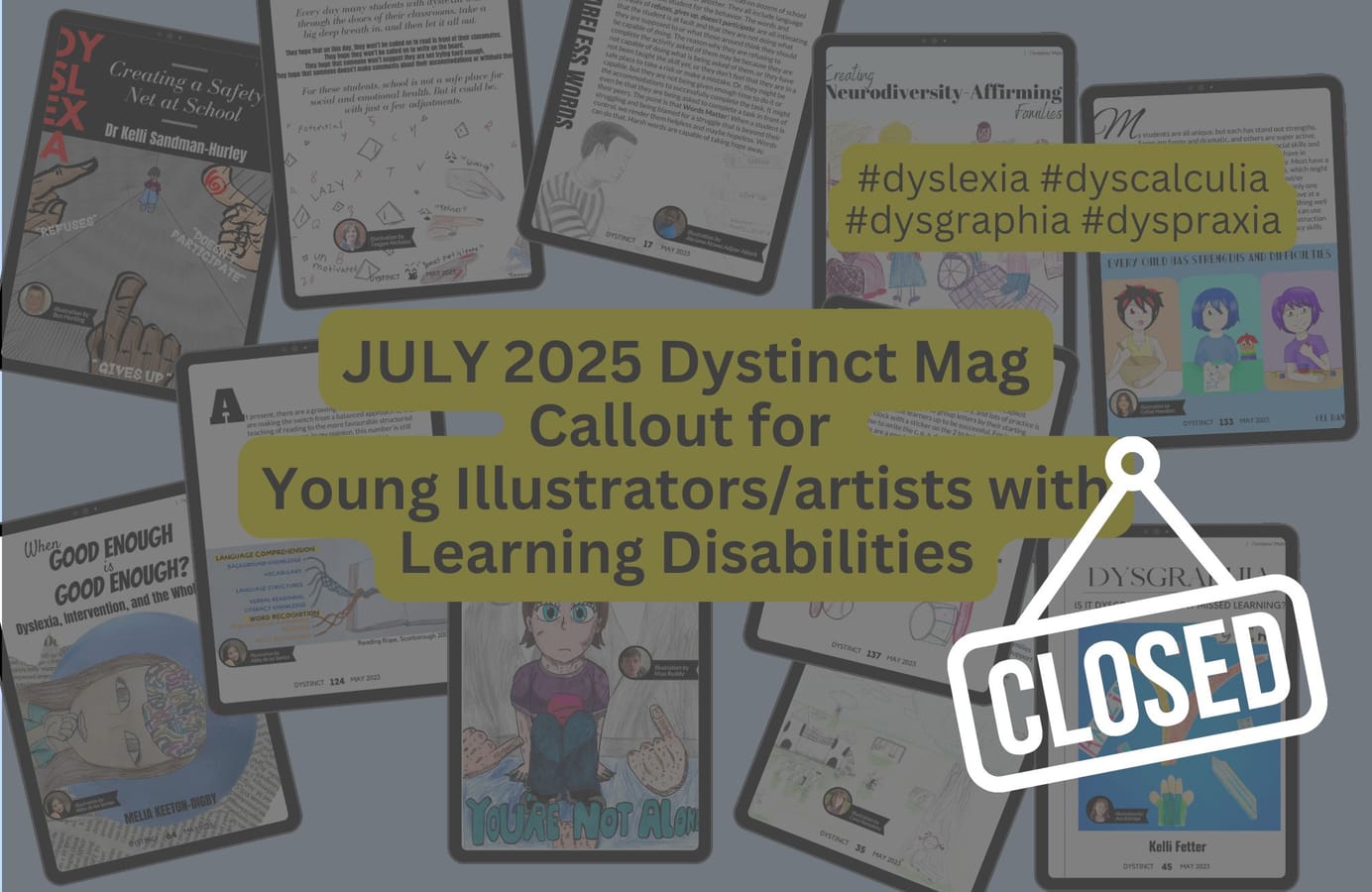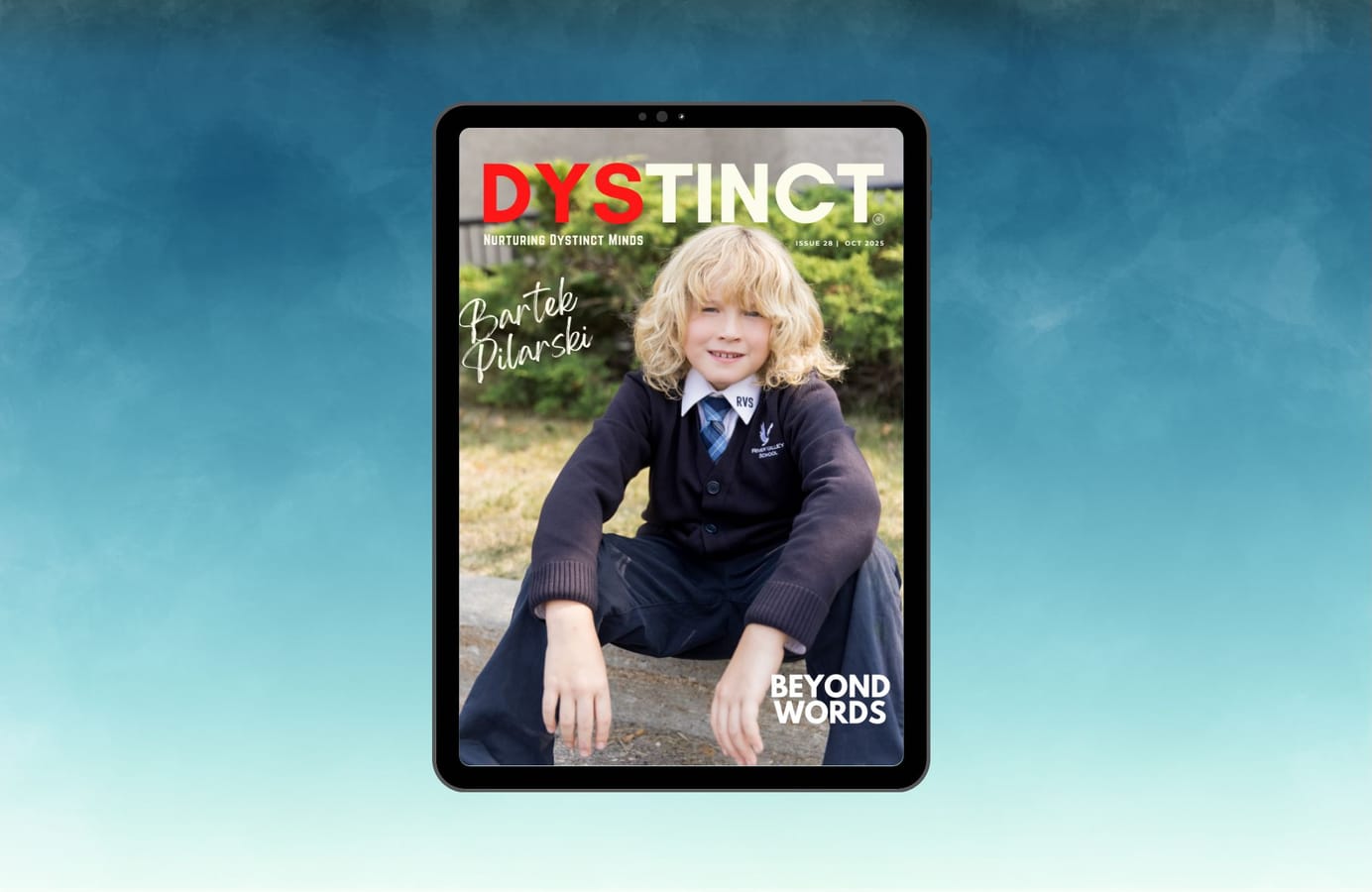
Issue 27: Illustration Callout for July 2025 Dystinct Magazine
Opportunity for children to get their illustrations published in the Dystinct Magazine. In every magazine issue, articles written by specialists are accompanied by illustrations created by children. Submit your child's illustrations for a chance to be featured in the Dystinct Magazine.
Table of Contents
Callouts for illustrations to be featured in the upcoming Apr 2025 issue of the Dystinct Magazine
Instructions to submit the illustrations are at the bottom. If you have any questions, please get in touch with me at hello@dystinct.org.
Callout 1 - Handwriting activates the reading brain in ways typing cannot
- Article Topic: How Can We Best Support Writing from the Beginning? What ALL Students Need to Know and Be Able to Do.
- Article Context: Amy Siracusano offers research-based insights into the foundational writing skills students need to succeed, highlighting the importance of explicit instruction in transcription skills such as handwriting and spelling, along with early support for oral language and fine motor development.
Illustration Guideline:
Children can feel free to create an illustration as per their creativity.
If you would like a suggestion, you can draw a scene with two children sitting side by side doing schoolwork. One child is writing with a pencil on paper or in a notebook, with a bright and colourful brain above their head to show that their brain is being stimulated. The other child is typing on a laptop, with a grey or black-and-white brain above their head to show their brain is not being stimulated as much.
Callout 2 - Talking builds writing skills
- Article Topic: How Can We Best Support Writing from the Beginning? What ALL Students Need to Know and Be Able to Do.
- Article Context: Amy Siracusano offers research-based insights into the foundational writing skills students need to succeed, highlighting the importance of explicit instruction in transcription skills such as handwriting and spelling, along with early support for oral language and fine motor development.
Illustration Guideline:
Children can feel free to create an illustration as per their creativity.
If you would like a suggestion, you can draw a warm, everyday setting like a dinner table or a cozy reading spot. Show a parent and young child having a lovely conversation with a book, a board game, and a puzzle laid out on the table or floor.
Callout 3 - Making PE sessions accessible for students with dyspraxia
- Article Topic: Dyspraxia in PE lessons
- Article Context: Anne Vize shares practical strategies for making Physical Education lessons more inclusive for students with dyspraxia, showing how a thoughtful ‘notice and adjust’ approach from warmups and skill-building activities to cool downs can help PE teachers create supportive and engaging environments where all children can participate, succeed, and enjoy movement at their own pace.
Illustration Guideline:
Children are welcome to create an illustration based on their own creativity and ideas.
If you require guideline, you can choose to draw a picture based on one of the ideas below:
- No one left behind
Draw a few kids playing catch but using different equipment that suits their needs. One might be catching a soft beach ball, another child using a Velcro mitt to catch a little beanbag and another child throwing and catching a tennis ball. Show the kids smiling and having fun, even though they’re all using different tools. - Dream PE station
Draw your dream PE station, a place where every kid can practise their movement skills in their own way. It might have softballs, balance boards, scooter boards, or a gentle obstacle course.
Callout 4 - Reading Time
- Article Topic: Using Story Grammar to Foster Comprehension
- Article Context: Jennifer Cerra shares how teaching story grammar, a structured approach to understanding narrative elements, can help struggling readers, especially those with dyslexia, build comprehension, reduce cognitive load, and connect more deeply with stories while strengthening oral language and decoding skills.
Illustration Guideline:
Children are welcome to create an illustration based on their own creativity and ideas.
If you’d like a bit of guidance, draw a teacher sitting or kneeling with a small group of students, each reading their own copy of the same book. The teacher engages the group by asking questions, and the children interact; some raise their hands, and others talk or point at their books. Behind the teacher, on a whiteboard or chart, are question words written in large letters: “Who,” “Where,” “When,” “What,” “How,” and “Why.”
Callout 5 - Practice makes perfect
- Article Topic: Practice, the Key to Remembering
- Article Context: Leslee Allen explains why consistent, deliberate practice is essential for helping students remember and apply what they learn and shares practical, research-informed strategies such as spaced practice, incremental rehearsal, and writing fluency routines that support all learners, especially those who struggle to retain and use what they learn with confidence.
Illustration Guideline:
Children are welcome to create an illustration based on their own creativity and ideas.
If you require a guideline, you can choose to draw a picture based on one of the ideas below:
- Brian Workout
Draw a brain doing a workout. The brain has arms and legs and is lifting a dumbbell with the word practice written on it. All around it are other dumbbells lying on the floor or resting nearby. Label the dumbbells with the words: Spaced Practice, Repetition, and Interleaved Practice. The setting can be a fun gym space, with motivational posters on the wall or a water bottle beside the brain. - Brain on a quest
Draw a cartoon-style brain running along a video game-style track. The brain is heading toward a treasure box or checkpoint labelled “Long-Term Memory.” Along the way, there are floating golden treasures or tokens in the air that the brain must collect. Each treasure is labelled: Spaced Practice, Repetition, and Interleaved Practice.
Callout 6 - Rejection
- Article Topic: Do you or someone you know have RSD?
- Article Context: Steve Hoersting, a licensed psychological practitioner, unpacks the roots and realities of Rejection Sensitive Dysphoria (RSD), especially in neurodivergent individuals. He offers insight into how early criticism can shape deep-seated beliefs and shares practical tools like CBT and mindfulness to help manage the emotional impact.
Illustration Guideline:
Children are welcome to create an illustration based on their own creativity and ideas.
If you require a guideline, you can choose to draw a picture based on one of the ideas below:
- Two-Faced Mirror
A child or teen looks into a mirror. One side shows a happy, confident reflection; the other side shows a reflection clouded with doubt, anxiety, or sadness, symbolising internal emotional contrast. - Storm and Sun
A person (child or adult) walks under a personal storm cloud while others are in sunny weather. This shows how rejection feels more intense to someone with RSD, even if others don’t perceive it. - Social Mask
A character holds up a smiling mask while visibly crying behind it, depicting the emotional masking often used by those with RSD.
Callout 7 - Reading together
- Article Topic: The Potential Impact of 15 Minutes.
- Article Context: Dr Jennifer Throndsen introduces dyad reading, a simple and evidence-based strategy where a stronger reader and a developing reader read aloud together, showing how just 15 minutes a day with appropriately challenging text can significantly boost fluency, comprehension, and confidence in struggling readers.
Illustration Guideline:
Children are welcome to create an illustration based on their own creativity and ideas.
If you’d like a bit of guidance, you can draw a parent and child sitting side by side, reading a book together. The book is open between them, and the parent is pointing to the words on the page while the child follows the word being pointed at with their eyes.
INSTRUCTIONS
Instructions for creating illustrations:
- If your child can create digital drawings, that would be preferred. If not, illustrations on paper will suffice. (If your child can create a digital illustration, please let me know about the software/platform they will use to create the file).
- Please create/draw/colour on an A4 sheet of WHITE paper.
- Scan the image and send us a clear image of the illustration without shadows. Please do not take a photograph using flash on your mobile device.
Instructions for submitting your illustrations:
Please email me your submissions to hello@dystinct.org with the following info:
- Short bio- 25-50 words
- Name of Child
- Age
- Location (City/Country)
- Diagnosis/suspected diagnosis
- 1-2 high-resolution headshots/ photos of the child
Illustrations featured in the previous issue of Dystinct Magazine
The below illustrations were featured in previous issues.






